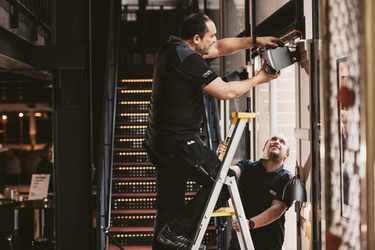Materiality analysis
Within the framework of Scandic’s materiality analysis, all stakeholder groups are selected based on whether they can influence or are influenced by the company’s business. No stakeholder group is excluded and dialogues are conducted at various frequencies.
Stakeholder dialogues
Scandic meets owners and investors, ESG analysts, corporate clients, partners and suppliers in more or less formal meetings several times a year. Other stakeholder groups interact with Scandic mainly through evaluations, surveys and seminars.
In addition to the systematic dialogue on sustainability issues, Scandic also holds regular discussions with employees and guests. Responses from the various stakeholder groups help Scandic in its sustainability initiatives and reporting.
| Stakeholder group | Main sustainability aspects based on earlier stakeholder dialogues |
|---|---|
| Team members |
|
| Owners and investors |
|
| NGOs |
|
| Future employees |
|
| Guests |
|
| Corporate customers |
|
| ESG analysts |
|
| Business partners |
|
Materiality analysis
Below is an overview of the modified materiality analysis with the areas identified based on dialogues that have been conducted. The starting point has been to select strategically important areas where permanent value can be created and where Scandic’s opportunities to have an influence are considered greatest.
Since Scandic has been engaged in sustainability initiatives since the early 90s, it is reasonably easy to address our most significant issues. There are two reasons for this.
- Scandic’s hotels are certified by the Nordic Swan Ecolabel. Their criteria help us both understand and take action to address the most significant issues faced by the hotel and restaurant industry.
Read more about the Nordic Swan Ecolabel criterias here - Scandic works with the Sustainable Hospitality Alliance, the industry’s global sustainability organization, which has also contributed to the fact that there is great consensus on which issues are the most significant.
Read more about the Sustainable Hospitality Alliance here
Areas where Scandic drives change
Environmental issues – many of these areas are interconnected and when aggregated help contribute to reducing CO2 emissions.
Social issues – these are especially important for Scandic as part of the service industry and in its role as a driver of integration in society.
- Diversity and inclusion (Scandic)
- Health (Scandic)
- Waste – reduction and recycling (Scandic and guests )
- Energy – heating/cooling and electricity (Scandic and property owners)
- Food & beverage (Scandic)
- CO2 emissions (Scandic and guests)
- Water (Scandic and guests)
- Materials & construction (Scandic and property owners)
Areas where Scandic strives for excellence every day
These key areas are integrated in Scandic’s daily operations and must be fulfilled to ensure Scandic’s success.
- Anti-trafficking (Scandic and guests)
- Fair and decent working conditions (Scandic)
- Health and safety – team members (Scandic and guests)
- Hotel safety – guests (Scandic and guests)
- Equal opportunities – gender (Scandic)
- Financial governance (Scandic)
- Transparency (Scandic)
- Anti-corruption (Scandic and suppliers)
- Customer privacy (Scandic)
Continue exploring

Vision & strategy
Our vision is to deliver world-class Nordic hotel experiences at hotels that are the most sustainable places to meet, eat and sleep away from home.
Read more
Sustainable hotel operations
Scandic aims to be a leader in sustainable hotel operations by investing continually in improvements and new sustain[1]able solutions and by engaging suppliers and property owners.
Read more
Good corporate citizen
Scandic aims to be and to be perceived as a responsible partner in society.
Read more